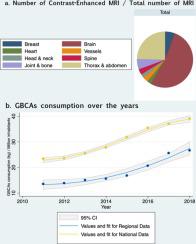Journal of Neuroradiology ( IF 3.5 ) Pub Date : 2020-03-14 , DOI: 10.1016/j.neurad.2020.03.004 Amandine Chazot 1 , Jean-Alix Barrat 2 , Mehdi Gaha 1 , Raphel Jomaah 3 , Julien Ognard 4 , Douraied Ben Salem 4

|
Background and purpose
Assess the evolution of gadolinium consumption and magnetic resonance imaging (MRI) scanners in France and Western Brittany (France) and compare regional practices between public and private hospitals for each organ specialty.
Material and methods
We collected data from national and universal health registries, and Western Brittany's health care structures, between 2011 and 2018, about the number of MR imaging exams and machines, the number of delivered GBCAs (gadolinium-based contrast agents), prescriptions and administration protocols.
Results
Over the last eight years, we observed an increase in the number of MRI machines implemented in France (62%), correlated with the increase of annual gadolinium consumption (amount of delivered GBCAs in kg, 64%), without modification of the annual quantity of gadolinium used per machine (2.7 kg in 2018). In Western Brittany, gadolinium impact is assigned to neuroimaging exams (50% CI95% [45;56] of all the contrast-enhanced exams), followed by thorax and abdomen exams (23% CI95% [18;28]). The ratio of injected exams to all exams is greater in public than in private hospitals (respectively 48% CI95% [46;49] versus 29% CI95% [26;30]).
Conclusion
Gadolinium consumption is increasing, correlated with the increase in the number of examinations carried out. Regionally, the main impact comes from neuroimaging exams. No change in practices has been observed in recent years despite some warnings about gadolinium deposits and environmental consequences.
中文翻译:

脑部MRI占据了医学成像中footprint足迹的大部分。
背景和目的
评估法国和西布列塔尼(法国)的consumption消耗量和磁共振成像(MRI)扫描仪的发展,并比较公立和私立医院针对每个器官专科的区域实践。
材料与方法
在2011年至2018年之间,我们从国家和全球卫生注册机构以及西布列塔尼的卫生保健机构收集了有关MR成像检查和机器的数量,已交付的GBCA(基于ga的造影剂)的数量,处方和给药方案的数据。
结果
在过去的八年中,我们观察到法国实施的MRI机器数量有所增加(62%),这与g的年度消费量增加(以公斤为单位的已交付GBCA数量,64%)相关,而未更改年度数量每台机器使用的g量(2018年为2.7千克)。在布列塔尼西部地区,g的影响被指定为神经影像检查(占所有对比增强检查的50%CI95%[45; 56]),其次是胸部和腹部检查(23%CI95%[18; 28])。在公立医院中,注射检查与所有检查的比例要大于私立医院(分别为48%CI95%[46; 49]和29%CI95%[26; 30])。
结论
consumption的消耗在增加,与进行检查的次数增加有关。在区域范围内,主要影响来自神经影像检查。尽管对despite的沉积物和环境后果提出了一些警告,但近年来没有观察到实践上的变化。



























 京公网安备 11010802027423号
京公网安备 11010802027423号